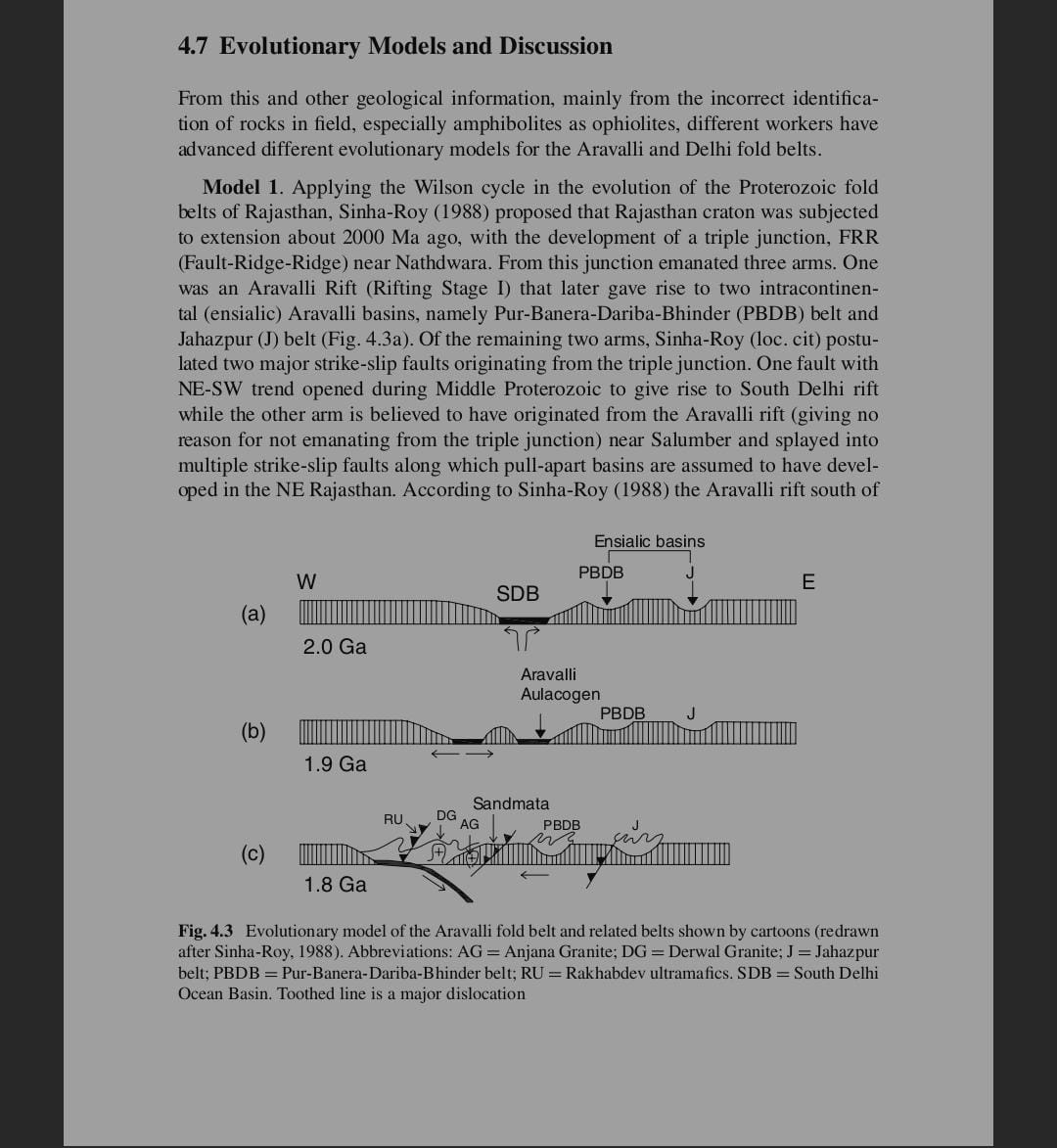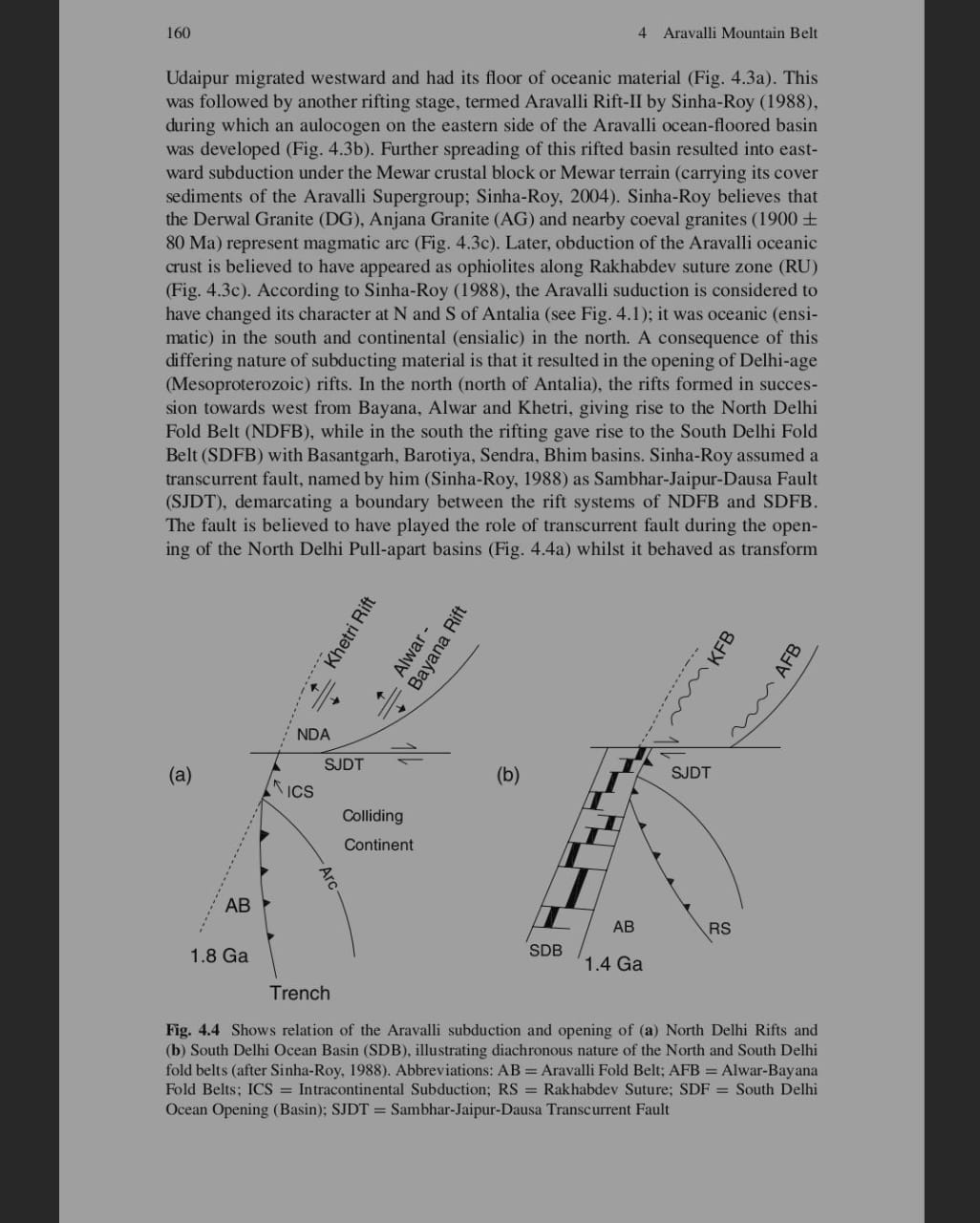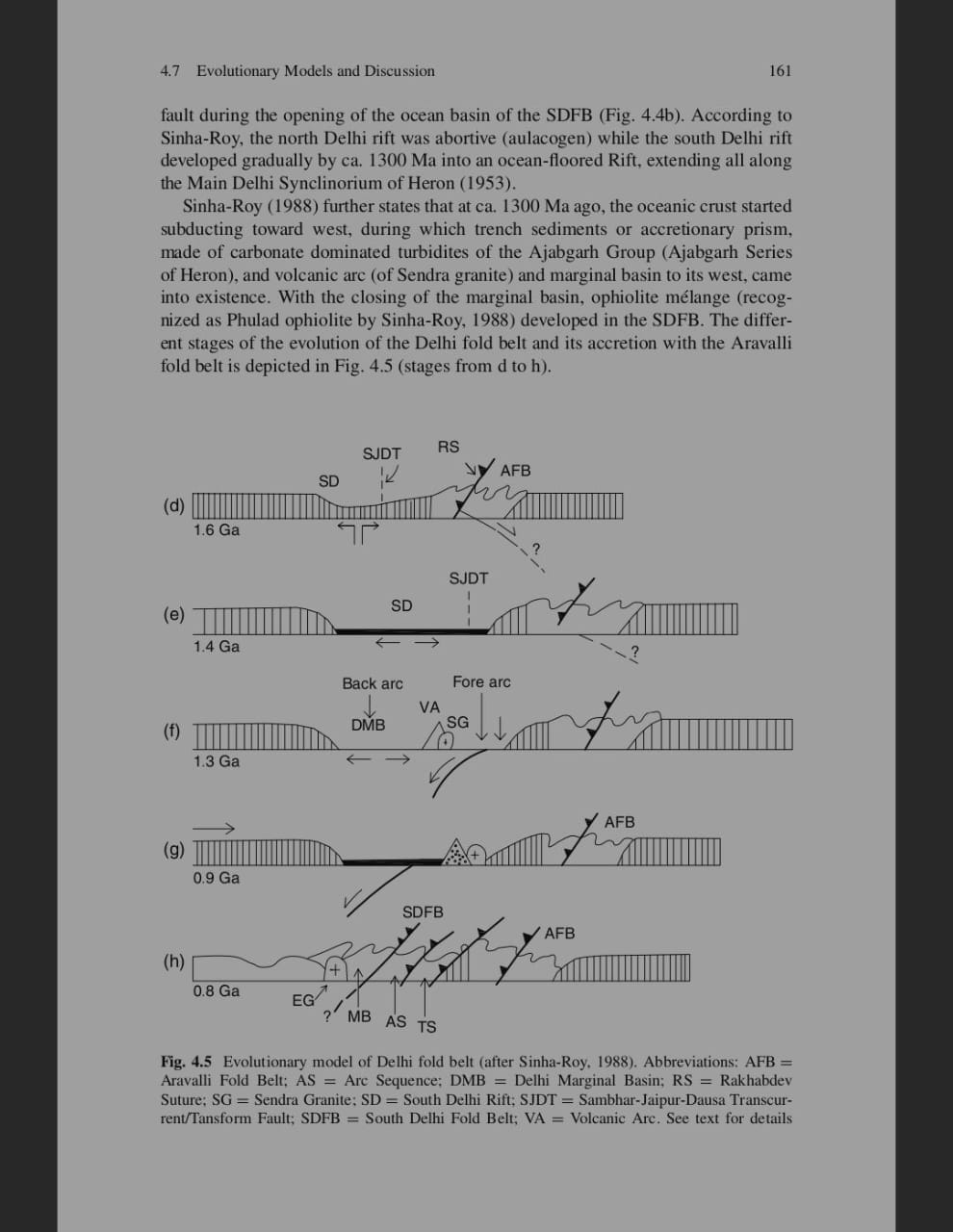Evolutionary Models of Rajasthan's Geological Belts
Evolutionary Models and Discussion

Overview
- The evolution of the Proterozoic fold belts in Rajasthan is modeled based on geological information and incorrect identifications of rocks, particularly amphibolites and ophiolites.
- Different researchers have developed various models for the Aravalli and Delhi fold belts.
Model 1: Wilson Cycle
- Concept: Proposed by Sinha-Roy (1988), this model relates to the evolution of the Rajasthan craton and involves the development of a triple junction around 2000 Ma ago.
- Key Feature: The triple junction, termed FRR (Fault-Ridge-Ridge), occurred near Nathdwara.
Features of the Model:
- Rifting Stage I:
- The Aravalli Rift initiated from this junction leading to two intra-continental (ensialic) Aravalli basins:
- PBDB Belt: Pur-Banera-Dariba-Bhinder.
- J Belt: Jahazpur.
- The Aravalli Rift initiated from this junction leading to two intra-continental (ensialic) Aravalli basins:
- Faults Originating from the Triple Junction:
- Major strike-slip faults developed from the triple junction:
- One fault directed towards South Delhi rift.
- Another arm believed to originate from the Aravalli rift.
- The rift's development involved multiple faults that resulted in pull-apart basins in NE Rajasthan.
- Major strike-slip faults developed from the triple junction:
Geological Timeframes:
- 2.0 Ga: Formation of ensialic basins (south Delhi basin (SDB) and Aravalli Aulacogen).
- 1.9 Ga: Further geological developments with noted formations continuing to evolve.
- 1.8 Ga: Notable changes in geological structures observed, with several regions identified.
Abbreviations:
- AG: Anjana Granite.
- DG: Derwal Granite.
- J: Jahazpur.
- PBDB: Pur-Banera-Dariba-Bhinder belt.
- RU: Rakhabdev ultramafics.
- SDB: South Delhi Ocean Basin.
- Dislocation: Major geological discontinuity in the structures.
Conclusion
- The evolutionary models highlight the complex geological history of the Aravalli and Delhi fold belts, offering insights into the structural evolution and tectonic events that shaped these regions over billions of years. Understanding these processes is crucial for geological mapping and studying mineral resources in Rajasthan.
Extended readings:
www.scirp.org
S. Sinha-Roy, “Proterozoic Wilson Cycle in Rajasthan,” Memoir ...
link.springer.com
978-3-642-01459-8.pdf
www.researchgate.net
Evolution of Proterozoic Aravalli Delhi Fold Belt in the northwestern ...
Notes on Aravalli Mountain Belt and Subduction Processes

Overview
- The Aravalli Mountain Belt is characterized by a series of geological processes, primarily involving rifting and subduction. This has significant implications for understanding the regional geology and tectonic history.
Rifting and Oceanic Material
- Rifting Stages: Udaipur migrated westward with a notable rifting stage referred to as the Aravalli Rift-II, delineated by Sinha-Roy (1988). This period involved the formation of an oceanic-foreland basin as rifting progressed.
- Oceanic Crust: The rift basin is believed to have had a floor made of oceanic material, indicating a complex geological structure.
Subduction Dynamics
- Eastward Subduction: The rifting led to eastward subduction beneath the Mewar crustal block, carrying sediments of the Aravalli Supergroup.
- Ophiolites: The term "ophiolite" refers to sections of the Earth's oceanic crust and the underlying upper mantle that have been uplifted and exposed above sea level. The Aravalli crust has been interpreted as having appeared as ophiolites.
Fault Systems
- Sambhar-Jaipur-Dausa Fault (SJDT) : This fault demarcates the boundary between the North Delhi Fold Belt (NDFB) and the South Delhi Fold Belt (SDFB), playing a crucial role in the tectonic development of the region.
- Transform Fault Dynamics: The SJDT fault is considered a transform fault, which means it accommodates horizontal displacement between adjoining tectonic plates.
Geological Features
Figures Elaborated
-
Fig. 4.4 (a) :
- Components: This diagram illustrates the North Delhi Rifts influenced by diastrophism, including the North Delhi Ocean Basin and tectonic lines such as SJDT and ICS (Intracontinental Subduction).
- Trench Representation: A trench formation (1.8 Ga) indicating deep geological processes.
-
Fig. 4.4 (b) :
- Features: The South Delhi Ocean Basin (SDB), further illustrating the diabolic features of the North and South Delhi Fold Belts (NDFB and SDFB).
- Ages: Geological periods indicated, with features developing around 1.4 Ga.
Abbreviations and Terminology
- AB: Aravalli Fold Belt
- AFB: Alwar-Bayana Fold Belt
- SDB: South Delhi Basin
- ICS: Intracontinental Subduction
- RS: Rakhabdev Suture
- SDF: South Delhi Fold
- NDFB: North Delhi Fold Belt
Insights and Additional Information
- The work of Sinha-Roy (1988) is crucial in establishing a chronology of geological events within the Aravalli region.
- The interplay of subduction and rifting is fundamental in shaping both the physical landscape and the geological composition of the area, highlighting the complex tectonic environment of the Aravalli Mountain Belt.
This structured note encapsulates the key geological concepts related to the Aravalli Mountain Belt as presented in the provided image, offering insights and clarifications on specific terms and processes.
Extended readings:
link.springer.com
978-3-642-01459-8.pdf
www.researchgate.net
(PDF) Cratons of the Indian Shield - ResearchGate
pubmed.ncbi.nlm.nih.gov
Subduction and collision processes in the Central Andes ... - PubMed
Evolutionary Models and Discussion of the Delhi Fold Belt

Key Points on the Delhi Fold Belt:
-
Opening of the Ocean Basin:
- Event: The fault related to the South Delhi Fold Belt (SDFB) marked the opening of the ocean basin.
- Details: The northern Delhi rift was identified as abortive (aulacogen) as per Sinha-Roy (1988), while the southern part developed gradually into an ocean-floored rift around 1300 Ma.
-
Subduction Events:
- Time Frame: Approximately 1300 Ma ago.
- Mechanism: The oceanic crust began to subduct westward, leading to trench sediments being formed.
- Composition: The sediments were made of carbonate-dominated turbidites and volcanic arcs, particularly the Ajabgarh Group and Sendra granite.
-
Closing of the Marginal Basin:
- Result: The marginal basin closure led to the development of an ophiolite mélange.
- Significance: Recognized by Sinha-Roy (1988), it played a crucial role in the geological evolution of the area.
-
Evolutionary Stages of the Delhi Fold Belt:
- The evolution through different geological phases is illustrated in Figure 4.5 (stages d to h).
- Stages Overview:
- (d) - Initial formation (1.6 Ga)
- (e) - Back arc and fore arc configuration developing (1.4 Ga)
- (f) - Further formation with the emergence of a Delaware Marginal Basin (1.3 Ga)
- (g) - Continued evolution leading up to 0.9 Ga
- (h) - Final stages around 0.8 Ga, including various geological features.
Diagram Summary (Fig. 4.5):
| Stage | Age (Ga) | Notable Features |
|---|---|---|
| (d) | 1.6 | Initial configuration |
| (e) | 1.4 | Back arc/fore arc development |
| (f) | 1.3 | Formation of Delaware Marginal Basin |
| (g) | 0.9 | Ongoing geological processes |
| (h) | 0.8 | Final evolutionary stages |
Abbreviations:
- AFB: Aravalli Fold Belt
- AS: Arc Sequence
- DMB: Delhi Marginal Basin
- RS: Rakhabdev Suture
- SG: Sendra Granite
- SD: South Delhi Rift
- SJDT: Sambhar-Jaipur-Dausa Transcurrent Fault
- SDFB: South Delhi Fold Belt
- VA: Volcanic Arc
Insights:
- The SDFB represents a crucial geological structure in understanding the tectonic evolution of the region.
- The subduction processes indicate significant geological activity, contributing to various rock formations and structures observed today.
- Understanding the dating and chronological development of these geological features is key to unraveling the tectonic history of the Delhi area.
Extended readings:
www.researchgate.net
Evolution of Proterozoic Aravalli Delhi Fold Belt in the northwestern ...
conference.khuisf.ac.ir
[PDF] Neoproterozoic tectonomagmatic evolution of the NW Indian craton
www.researchgate.net
Geological map of the Aravalli-Delhi Fold Belt and adjacent rocks of...